For the 2025 school year, there are 2 public middle schools serving 489 students in Woodlake Unified School District. This district's average middle testing ranking is 2/10, which is in the bottom 50% of public middle schools in California.
Public Middle Schools in Woodlake Unified School District have an average math proficiency score of 12% (versus the California public middle school average of 31%), and reading proficiency score of 25% (versus the 46% statewide average).
Minority enrollment is 93% of the student body (majority Hispanic), which is more than the California public middle school average of 78% (majority Hispanic).
Overview
This School District
This State (CA)
# Schools
6 Schools
3,501 Schools
# Students
2,085 Students
1,854,363 Students
# Teachers
103 Teachers
87,821 Teachers
Student : Teacher Ratio
20:1
20:1
District Rank
Woodlake Unified School District, which is ranked #1636 of all 1,925 school districts in California (based off of combined math and reading proficiency testing data) for the 2021-2022 school year.
The school district's graduation rate of 90-94% has increased from 85-89% over five school years.
Overall District Rank
#1649 out of 1941 school districts
(Bottom 50%)
(Bottom 50%)
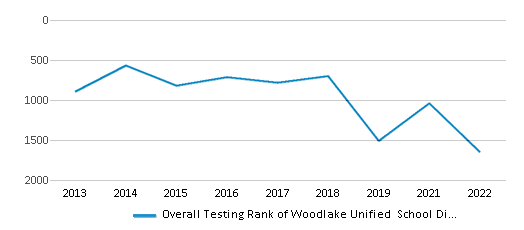
Math Test Scores (% Proficient)
14%
33%
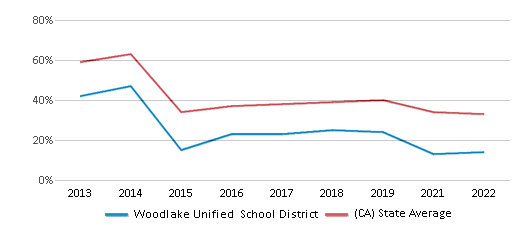
Reading/Language Arts Test Scores (% Proficient)
28%
47%
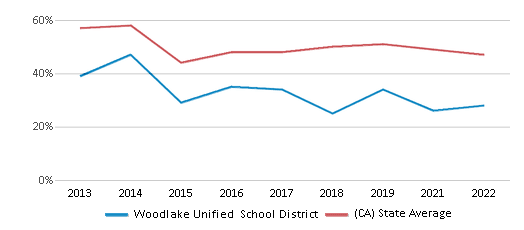
Science Test Scores (% Proficient)
13%
29%
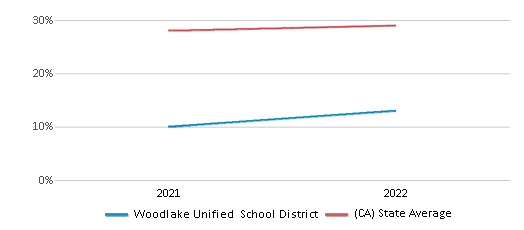
Graduation Rate
90-94%
87%
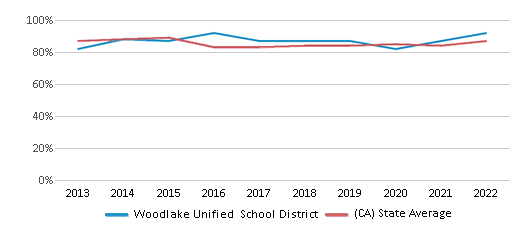
Students by Ethnicity:
Diversity Score
0.17
0.64
# American Indian Students
12 Students
9,887 Students
% American Indian Students
n/a
1%
# Asian Students
14 Students
201,760 Students
% Asian Students
1%
11%
# Hispanic Students
1,891 Students
1,009,980 Students
% Hispanic Students
91%
55%
# Black Students
1 Student
97,908 Students
% Black Students
n/a
5%
# White Students
164 Students
413,325 Students
% White Students
8%
22%
# Hawaiian Students
n/a
7,600 Students
% Hawaiian Students
n/a
n/a
# Two or more races Students
2 Students
109,003 Students
% of Two or more races Students
n/a
6%
Students by Grade:
# Students in PK Grade:
-
83
# Students in K Grade:
193
90,358
# Students in 1st Grade:
147
70,728
# Students in 2nd Grade:
132
73,359
# Students in 3rd Grade:
150
73,090
# Students in 4th Grade:
129
76,068
# Students in 5th Grade:
141
82,191
# Students in 6th Grade:
157
289,122
# Students in 7th Grade:
180
439,549
# Students in 8th Grade:
145
441,705
# Students in 9th Grade:
175
59,696
# Students in 10th Grade:
184
51,846
# Students in 11th Grade:
174
51,149
# Students in 12th Grade:
178
55,419
# Ungraded Students:
-
-
District Revenue and Spending
The revenue/student of $19,533 in this school district is less than the state median of $19,974. The school district revenue/student has stayed relatively flat over four school years.
The school district's spending/student of $16,139 is less than the state median of $18,396. The school district spending/student has stayed relatively flat over four school years.
Total Revenue
$41 MM
$116,387 MM
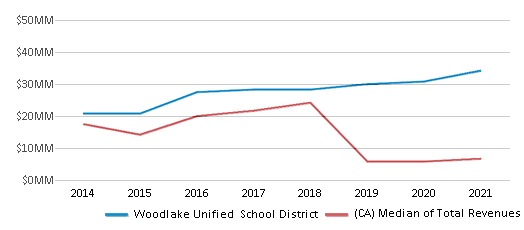
Spending
$34 MM
$107,188 MM

Revenue / Student
$19,533
$19,974
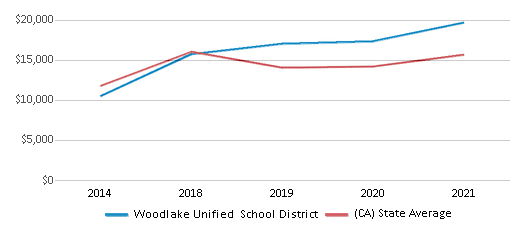
Spending / Student
$16,139
$18,396

Best Woodlake Unified School District Public Middle Schools (2025)
School
(Math and Reading Proficiency)
(Math and Reading Proficiency)
Location
Grades
Students
Rank: #11.
Woodlake Valley Middle School
(Math: 12% | Reading: 25%)
Rank:
Rank:
2/
Bottom 50%10
497 North Palm St.
Woodlake, CA 93286
(559) 564-8061
Woodlake, CA 93286
(559) 564-8061
Grades: 6-8
| 480 students
Rank: n/an/a
Woodlake Community Day
Alternative School
36220 Millwood Dr.
Woodlake, CA 93286
(559) 564-8716
Woodlake, CA 93286
(559) 564-8716
Grades: 7-12
| 9 students
Recent Articles

Year-Round Or Traditional Schedule?
Which is more appropriate for your child? A year-round attendance schedule or traditional schedule? We look at the pros and cons.

Why You Should Encourage Your Child to Join a Sports Team
Participating in team sports has a great many benefits for children, there is no doubt. In this article you will learn what those benefits are.

White Students are Now the Minority in U.S. Public Schools
Increasing birth rates among immigrant families from Asia and Central and South America, combined with lower birth rates among white families, means that for the first time in history, public school students in the United States are majority-minority. This shift in demographics poses difficulties for schools as they work to accommodate children of varying language abilities and socio-economic backgrounds.





